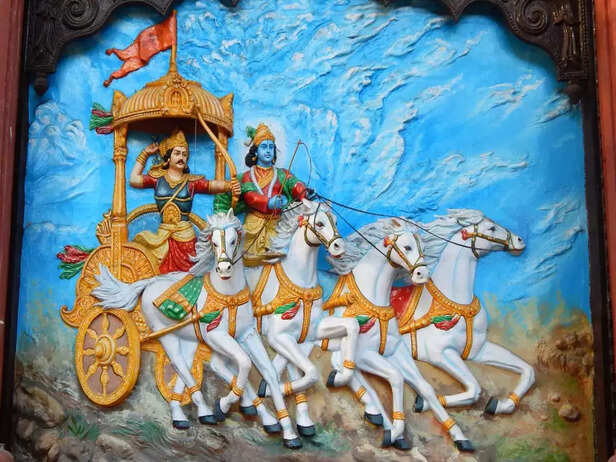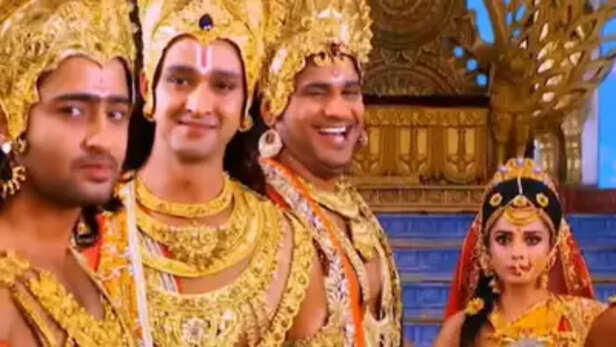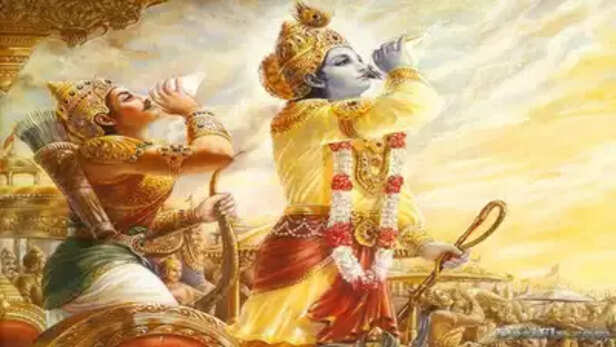Karma’s Grand Drama – Shocking Lessons on Fate and Free Will from Hindu Epics!
Mili verma | Mar 19, 2025, 22:04 IST
Mahabharat
Explore the profound teachings of fate and free will through the lens of Hindu epics. Delve into the epic narratives of Mahabharata and Ramayana to uncover timeless wisdom on karma, destiny, and the interplay between human choices and cosmic design.
The concept of karma and destiny is deeply rooted in Hindu philosophy, forming the core of human existence as depicted in ancient scriptures. The Mahabharata and Ramayana are two of the most revered Hindu epics that illustrate the intricate relationship between fate and free will. These texts do not simply tell stories of divine interventions and legendary battles; they also serve as profound treatises on life, morality, and the consequences of human actions. By examining key characters and events from these epics, we can better understand how karma shapes destiny, how free will interacts with cosmic order, and how these age-old lessons remain relevant even today.
Karma, derived from the Sanskrit root kri (meaning “to do”), signifies action and its consequences. Hindu philosophy asserts that every action—whether physical, mental, or emotional—leaves an imprint on an individual’s life path. While fate (prarabdha karma) is the portion of past karma that manifests in one’s present life, free will (purushartha) allows individuals to shape their future through conscious decisions. The epics of Mahabharata and Ramayana exemplify how this cosmic balance unfolds in the grand drama of human existence.
The Mahabharata – A Battlefield of Fate and Free Will

The Mahabharata, one of the longest and most complex epics in world literature, is a saga of duty, righteousness, and cosmic justice. The war of Kurukshetra, the central conflict of the epic, is not merely a battle for the throne but a stage where profound philosophical discourses on fate and free will take place.
Krishna’s Guidance to Arjuna – The Bhagavad Gita’s Wisdom
A pivotal moment in the Mahabharata is when Arjuna, the great warrior of the Pandavas, faces a moral crisis on the battlefield. Overwhelmed by the prospect of killing his own kin, he hesitates. Lord Krishna, his charioteer and divine guide, enlightens him through the Bhagavad Gita, teaching that one must fulfill their dharma (duty) without attachment to the fruits of their actions. Krishna emphasizes that while fate may place one in a situation, free will determines how they respond. This lesson resonates beyond the battlefield, shaping the way individuals navigate ethical dilemmas in their own lives.
Duryodhana – A Victim of Fate or His Own Choices?
Duryodhana, the antagonist of the Mahabharata, is often seen as a tragic figure torn between destiny and personal ambition. He was warned multiple times by elders such as Bhishma, Vidura, and Krishna to abandon his greed and hatred. However, Duryodhana’s arrogance and refusal to change his ways led to his downfall. His story serves as a cautionary tale that while fate may offer opportunities for redemption, it is ultimately one’s choices that seal their destiny.
Karna – Bound by Fate, Yet Defined by Free Will
Another compelling character in the Mahabharata is Karna, the warrior who was born to Kunti but abandoned at birth. Despite being of noble birth, he was raised as a charioteer’s son and denied the privileges of a Kshatriya (warrior class). Karna’s life is a poignant example of how fate can be cruel, but free will allows individuals to carve their own path. His unwavering loyalty to Duryodhana, despite knowing he was on the wrong side, highlights the moral complexities of free will and duty.
The Ramayana – Dharma and Destiny Interwoven
The Ramayana is another great Hindu epic that explores the themes of karma, fate, and duty. Unlike the Mahabharata, which is filled with grey areas, the Ramayana presents a clearer distinction between good and evil. However, it still offers deep insights into the delicate balance between destiny and personal responsibility.
Rama – The Embodiment of Dharma
Lord Rama, the protagonist of the Ramayana, is regarded as Maryada Purushottama, the perfect man. His life is a testament to unwavering adherence to dharma, even in the face of adversity. When he was exiled from Ayodhya due to his stepmother Kaikeyi’s boon, Rama could have resisted. However, he accepted his fate gracefully, demonstrating how one’s response to destiny defines their character.
Ravana – The Power of Free Will Used Wrongly
Ravana, the demon king of Lanka, is another example of free will in action. A highly learned scholar and a devotee of Lord Shiva, Ravana had the potential to be a great ruler. However, his arrogance and disregard for dharma led him to abduct Sita, setting in motion his own destruction. Ravana’s tale warns of the perils of misusing free will and ignoring the moral compass that guides humanity.
Sita – The Test of Fate and Strength of Character

Sita, the wife of Rama, undergoes numerous trials, from her abduction by Ravana to the Agni Pariksha (trial by fire) and eventual exile. Despite the injustices she faced, she remained steadfast in her virtue and strength. Her story teaches that while fate may bring suffering, inner resilience and adherence to truth ultimately lead to spiritual triumph.

The lessons of fate and free will from the Mahabharata and Ramayana remain deeply relevant in today’s world. Whether in personal relationships, professional struggles, or moral dilemmas, individuals constantly navigate the balance between destiny and choice.

The Hindu epics Mahabharata and Ramayana weave an intricate dance between karma, fate, and free will. They illustrate that while destiny may create circumstances, it is our choices that ultimately shape our lives. Krishna’s wisdom, Rama’s righteousness, Karna’s struggles, and Ravana’s downfall all serve as eternal reminders that human actions are the architects of their own fate. By internalising these lessons, we can navigate life’s challenges with clarity, purpose, and a deep understanding of the cosmic law of karma.
Explore the latest trends and tips in Health & Fitness, Travel, Life Hacks, Fashion & Beauty, and Relationships at Times Life.
Understanding Karma, Fate, and Free Will
The Mahabharata – A Battlefield of Fate and Free Will

Kurukshetra: Battle Field
The Mahabharata, one of the longest and most complex epics in world literature, is a saga of duty, righteousness, and cosmic justice. The war of Kurukshetra, the central conflict of the epic, is not merely a battle for the throne but a stage where profound philosophical discourses on fate and free will take place.
Krishna’s Guidance to Arjuna – The Bhagavad Gita’s Wisdom
A pivotal moment in the Mahabharata is when Arjuna, the great warrior of the Pandavas, faces a moral crisis on the battlefield. Overwhelmed by the prospect of killing his own kin, he hesitates. Lord Krishna, his charioteer and divine guide, enlightens him through the Bhagavad Gita, teaching that one must fulfill their dharma (duty) without attachment to the fruits of their actions. Krishna emphasizes that while fate may place one in a situation, free will determines how they respond. This lesson resonates beyond the battlefield, shaping the way individuals navigate ethical dilemmas in their own lives.
Duryodhana – A Victim of Fate or His Own Choices?
Duryodhana, the antagonist of the Mahabharata, is often seen as a tragic figure torn between destiny and personal ambition. He was warned multiple times by elders such as Bhishma, Vidura, and Krishna to abandon his greed and hatred. However, Duryodhana’s arrogance and refusal to change his ways led to his downfall. His story serves as a cautionary tale that while fate may offer opportunities for redemption, it is ultimately one’s choices that seal their destiny.
Karna – Bound by Fate, Yet Defined by Free Will
Another compelling character in the Mahabharata is Karna, the warrior who was born to Kunti but abandoned at birth. Despite being of noble birth, he was raised as a charioteer’s son and denied the privileges of a Kshatriya (warrior class). Karna’s life is a poignant example of how fate can be cruel, but free will allows individuals to carve their own path. His unwavering loyalty to Duryodhana, despite knowing he was on the wrong side, highlights the moral complexities of free will and duty.
The Ramayana – Dharma and Destiny Interwoven
The Ramayana is another great Hindu epic that explores the themes of karma, fate, and duty. Unlike the Mahabharata, which is filled with grey areas, the Ramayana presents a clearer distinction between good and evil. However, it still offers deep insights into the delicate balance between destiny and personal responsibility.
Rama – The Embodiment of Dharma
Lord Rama, the protagonist of the Ramayana, is regarded as Maryada Purushottama, the perfect man. His life is a testament to unwavering adherence to dharma, even in the face of adversity. When he was exiled from Ayodhya due to his stepmother Kaikeyi’s boon, Rama could have resisted. However, he accepted his fate gracefully, demonstrating how one’s response to destiny defines their character.
Ravana – The Power of Free Will Used Wrongly
Ravana, the demon king of Lanka, is another example of free will in action. A highly learned scholar and a devotee of Lord Shiva, Ravana had the potential to be a great ruler. However, his arrogance and disregard for dharma led him to abduct Sita, setting in motion his own destruction. Ravana’s tale warns of the perils of misusing free will and ignoring the moral compass that guides humanity.
Sita – The Test of Fate and Strength of Character

Sita: Strength of character
Sita, the wife of Rama, undergoes numerous trials, from her abduction by Ravana to the Agni Pariksha (trial by fire) and eventual exile. Despite the injustices she faced, she remained steadfast in her virtue and strength. Her story teaches that while fate may bring suffering, inner resilience and adherence to truth ultimately lead to spiritual triumph.
Relevance of These Lessons in Modern Life

Lessons of fate and free will.
The lessons of fate and free will from the Mahabharata and Ramayana remain deeply relevant in today’s world. Whether in personal relationships, professional struggles, or moral dilemmas, individuals constantly navigate the balance between destiny and choice.
- In Career and Success: Just as Arjuna had to overcome self-doubt to fulfill his duty, professionals today must recognise their strengths and take decisive action despite uncertainties.
- In Ethics and Decision-Making: Duryodhana’s downfall reminds us that ignoring ethical advice and choosing greed over righteousness leads to ruin.
- In Relationships and Responsibility: Rama’s unwavering commitment to dharma teaches the importance of honouring responsibilities even in challenging situations.
- In Overcoming Adversity: Sita’s endurance exemplifies the power of inner strength when faced with hardships.

Ramayana
The Hindu epics Mahabharata and Ramayana weave an intricate dance between karma, fate, and free will. They illustrate that while destiny may create circumstances, it is our choices that ultimately shape our lives. Krishna’s wisdom, Rama’s righteousness, Karna’s struggles, and Ravana’s downfall all serve as eternal reminders that human actions are the architects of their own fate. By internalising these lessons, we can navigate life’s challenges with clarity, purpose, and a deep understanding of the cosmic law of karma.
Explore the latest trends and tips in Health & Fitness, Travel, Life Hacks, Fashion & Beauty, and Relationships at Times Life.
